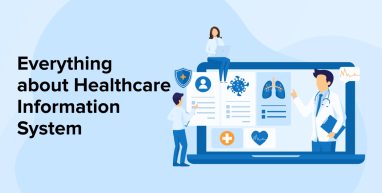
Technology has entered almost all sectors today. The proper implementation of technological advancements can benefit the industry in multiple ways. One such crucial sector where technology is playing wonders is the healthcare sector.
The use of innovations such as AI, laser, 3D printing, wearable devices, AI/VR, CRISPR technology, etc., can be easily observed in the medical field. Healthcare information technology is gaining prominence these days. Multiple healthcare centers have already adopted this system, and others are in the race to implement it to improve patient care. A Health Information System (HIS) is a repository of data from multiple sources in a single place to give a 360-degree view of the patient’s medical history.
In this blog post, we’ll discuss what Health Information Systems mean, their components, the advantages they bring to the health industry, their characteristics, and their different types of implementation.
1. What is a Health Information Systems?
A Health Information System (HIS) enables healthcare organizations to collect, store, process, analyze, and transmit the patient’s medical information to make correct decisions to improve the patient’s healthcare. The data is collected from all the sources where the patient has previously received medical care. It may be private hospitals, clinics, government health centers, family doctor consultations, etc.
HIS integrates healthcare with information technology. It fosters data-driven decision-making, providing the right kind of treatment at the right time. It thus improves the effectiveness of healthcare institutions in delivering better patient outcomes.
1.1 Key Components of Health Information System
A healthcare information system (HIS) is a collection of specific data systems that collaborate to monitor and control different aspects of healthcare services. The list below consists of a few of the most important parts of healthcare information systems.
1. Core Administration Management
Health information technology systems typically consist of either standalone or cloud-based hardware and software for management purposes. Using this system, every department affiliated with the healthcare system can have its daily activities recorded and integrated.
2. Financial Software
The healthcare system needs a financial component to manage the revenue cycles efficiently and without any errors. Financial software is a set of interconnected SaaS accounting and management plug-ins. The healthcare organization’s bottom line and its ability to invest in value-adding operations can both be improved with careful management of the finances.
3. ERP/Personnel Management Tools
Health Information Systems manage both employees and patients. Tools and features like transparent resource allocation, interactions, and booking appointments among patients and doctors within hospitals and departments are all made easier with the aid of these healthcare IT solutions. A large ERP system provider carefully takes into account the potential in the healthcare sector of its expanding market.
4. Keeping Track of Patient Health Records
When it comes to establishing a comprehensive HIS in healthcare, electronic health record (EHR) and medical record (EMR) information systems are invaluable tools for keeping tabs on patients’ visits, financial data, care notes, etc. Appropriate access control aids in maintaining encrypted and secure health information system portals, which are essential for protecting sensitive data such as patient information and financial records.
5. Asset Tracking
Hospital personnel can keep tabs on stock at every stage of the inventory lifecycle, from acquisition to reimbursement, with the help of asset monitoring or medical inventory management systems. Whether it’s medications or surgical instruments, when an item in stock is about to expire, it can be restocked. In terms of keeping track of inventory, it’s a way to make sure that everyone is following the rules.
1.2 Benefits of Healthcare Information Systems
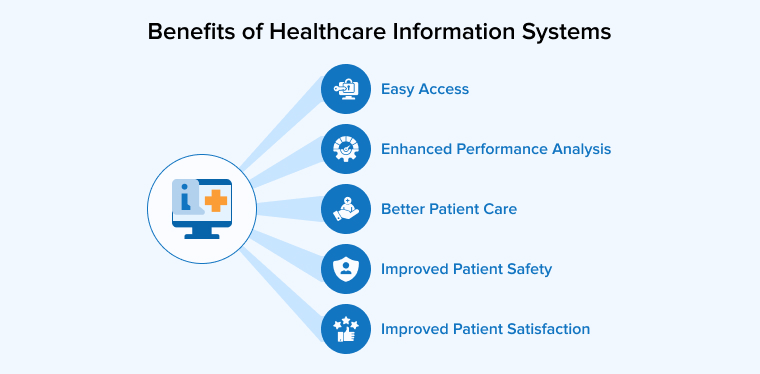
Let’s dig deeper into the benefits of the Health Information system.
1. Easy Access
With a well-implemented health system, patient data is readily available. All it takes is a matter of a few clicks, and healthcare professionals get to know everything. If the usual treating doctor is absent and another professional needs to review the test reports, they can simply log in to the HIS and have instant access to the patient’s medical history and current scenario.
2. Enhanced Performance Analysis
HIS has excellent data analytics capabilities. It can collect, consolidate and assess data from various sources. Using predetermined metrics, HIS allows you to keep track of employee or team performance and organizational efficiency. Healthcare Information Systems can evaluate huge amounts of data to provide valuable insights into gaps and vulnerabilities in patient treatments and organizational policies.
3. Better Patient Care
HIS gives you instant and uninterrupted access to the comprehensive medical records of the patient. This allows you to understand their pre-existing conditions, ongoing medications, etc, and provide suitable treatments.
On top of that, HIS helps foster coordinated care, including the primary doctors, test laboratories, pharmacists, and more, to ensure that the patient’s records and medical history stay unified and updated.
Such an integrated approach is helpful in making accurate diagnoses, devising improved treatment plans, and obtaining better outcomes.
4. Improved Patient Safety
Health information systems have data management capabilities, including collecting, storing, editing, and sharing sensitive personal information and medical records. Therefore, HIS software is equipped with robust security protocols to safeguard patient information. The system also allows healthcare practitioners to monitor patients’ conditions remotely. They receive an alert with the necessary details if the patient’s health seems to be worsening. Such proactive warnings allow healthcare organizations to avert any catastrophe.
5. Improved Patient Satisfaction
Hospitals can boost patient satisfaction rates through healthcare information systems. HIS, such as patient portals, are designed for the convenience of the patients by providing them quick access to test results and other medical records. They can also use it to communicate with their doctors, and schedule appointments or tests.
Other HIS systems are also leveraged to increase organizational efficiency and create better treatment plans. Patients will be highly satisfied if they can navigate through your administrative workflow without any hassle, and their health improves at the end of it.
2. Examples of Health Information System(HIS)
Let’s examine some common types of Healthcare Information Systems.
2.1 EMR and EHR
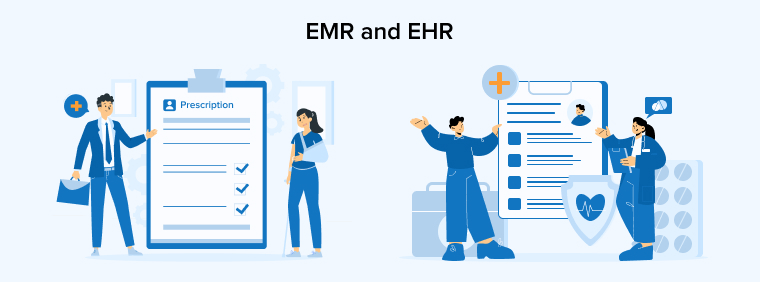
EMR and EHR are often used as interchangeable terms, but there is a simple yet significant difference between them.
EMR, in simple words, replaces the paper version of a patient’s health history. Ranging from health data to test results and treatments, EMR systems cover it all in the health space.
Let’s see what Twitter user Kelly Anderson thinks about EMR software.
A patient’s Electronic Medical Record (EMR) is their permanent record within the clinic’s IT infrastructure. Hospitalists, family doctors, and specialists are some of the regular users of these records.
Having a physical copy of the medical record, a file of sorts in a doctor’s office, is standard practice, and most patients understand this. The patient’s entire medical history is documented in this file, including all of their diagnoses, test findings, and treatments.
Meanwhile, Electronic medical records (EMRs) are a computerized replacement for the traditional paper medical chart, providing certain benefits:
- Electronic medical records allow doctors to keep better tabs on patient records over time.
- Data processing tasks can be digitally automated with the help of EMRs. An electronic medical record system (EMR) may notify doctors, for instance, that a patient has to come in for a checkup or preventative screening.
- With EMR data, doctors may see how their patients are performing according to predetermined benchmarks like blood pressure, immunization records, and so on.
These records may need to be printed before they can be shared with other healthcare professionals.
On the other hand, EHR is a digital record that is not limited to the patient’s medical records and covers a broader range of healthcare information, including EMR and other details such as:
- Medical appointments with specialists.
- Data about medical coverage.
- Healthcare facility documentation and more.
Electronic health records (EHRs) were developed to standardize patient information across remote medical professionals.
2.2 Practice Management Software (PMS)
A Practice Management System (PMS) is a software application designed to assist healthcare facilities in managing billing and administrative responsibilities efficiently. It can arrange appointments, monitor patient information, and handle insurance claims. Implementing a PMS at your facility can enhance operational efficiency and facilitate effective internal communication among employees.
2.3 Master Patient Index
The Master Patient Index (MPI) is an electronic record that assigns individuals a unique identifier depending on their geographic location. This system allows for easy cross-references between medical facilities and networks, including hospitals, doctors, laboratories, and radiology clinics.
Several big medical facilities utilize this system to store patient information. After being archived, the information can be accessed by any affiliated hospital or medical center. This MPI generates a searchable index of a patient’s medical history that can be easily accessed by any department.
To prevent inaccurate information that leads to unequal treatment, MPI aims to minimize patient record duplication. Healthcare data may be transferred more conveniently and at a lower cost if patient information is stored within the program.
2.4 Patient Portals
A patient portal is a web portal that enables patients to view their health records, such as their treatment history, current medications, and any upcoming appointments.
A patient portal is often available around the clock, seven days a week, and may be accessed from any internet-enabled device, such as a smartphone, desktop computer, laptop computer, or tablet.
Appointments can be made and direct communication with the healthcare staff is also possible through a patient portal.
2.5 Clinical Decision Support
A clinical decision support (CDS) system is a software tool designed to assist healthcare practitioners in making informed decisions regarding a patient’s clinical treatment. It accesses and analyzes patient data from multiple subsystems to give large-scale, evidence-based insights and recommendations, improving medical diagnosis and quick healthcare delivery. A CDS gathers data from both clinical and administrative systems. Using this system lessens the probability of medical errors, provides personalized care, ensures regulatory compliance, simplifies the workflow, and saves costs.
There are two types of clinical decision support systems:
- Knowledge-based (CDSS): It provides insights based on medical records, clinical practices, established protocols, and guidelines.
- Non-knowledge-based (CDSS): It uses AI and ML algorithms to learn from the data patterns and provide recommendations.
2.6 Remote Patient Monitoring

Remote Patient Monitoring (RPM) is another example of HIS that employs technology to monitor patient health remotely. It involves the electronic transmission of health information from patients to physicians and represents a distinct approach within the wider telemedicine field.
3. Features of Healthcare Information System
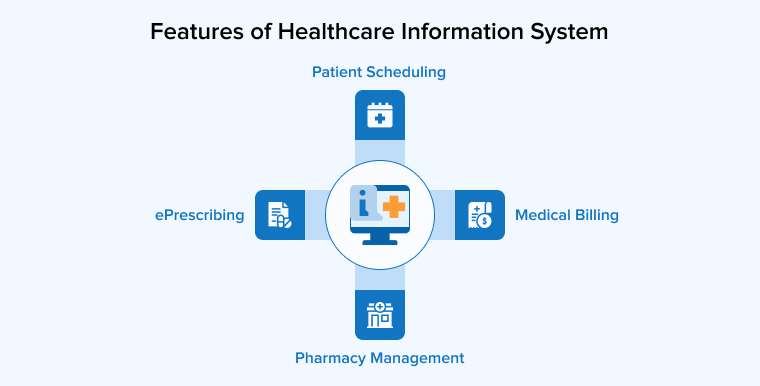
As we already discussed the benefits of a healthcare information system, now, it’s time to understand what features are offered or can be incorporated into a healthcare information system. Here are a few of the most common and helpful features to consider:
3.1 Medical Billing
Keeping track of each aspect of invoicing is a huge time sink for medical practices, particularly in hectic medical facilities where time is limited. From the time an appointment is scheduled until payment is finalized, the whole billing procedure is taken care of by medical billing software.
The system offers more than just patient billing; it verifies insurance, processes payments, and keeps records of what patients purchase. In the event of a problem, such as a late payment, the system will notify you so that you can take the necessary steps.
3.2 Patient Scheduling
Patients book an appointment with the doctors or perform tests using patient scheduling, just as they do through the patient portal. In this manner, patients can skip the hassle of repeatedly calling the clinic to schedule an appointment or standing in line outside the doctor’s office.
Patients can access every service with the touch of a button. They can even schedule appointments based on their convenience and the doctor’s availability. Even healthcare providers can benefit from this capability. They are free to allocate staff, lab space, and specialized equipment as required.
3.3 ePrescribing
Hospital information system software can provide tailored designs that ensure secure communications of e-prescriptions among different patients, drugstores, and claim agencies. This tailored approach allows for a complete workflow that meets the specific needs of the hospital. By supporting safe electronic data transmission and facilitating error-free medication and payments, this e-prescribing approach enhances patient satisfaction. Compliance with HIPAA standards ensures the safekeeping of any patient data stored within the system.
3.4 Pharmacy Management
Electronic Health Records (EHRs) and Electronic Medical Records (EMRs) can be organized and managed through the hospital information system. These managed documents include sections for patients’ profiles, claims and payment information, medical history, x-rays and tests, and doctors’ observations and supporting files.
The pharmaceutical data management system is actively aiming to incorporate audit needs as well as billing-related upgrades and revisions. By connecting with healthcare automation, hospital information systems can generate customized prescription packages for each patient based on their particular needs. This approach is vital to the hospital’s bottom line because it allows it to provide patients with individualized, value-based treatment that meets their specific needs.
4. Conclusion
As seen in this blog, healthcare information systems are transforming the present and the future of healthcare services. These systems help hospitals and clinics bring the revolution in the ways they deliver patient care. They offer robust medical procedures, increase the efficiency of medical professionals, and make the entire healthcare system organized. This proves that the effective implementation of HIS is a win-win for both the healthcare service providers and the patients.


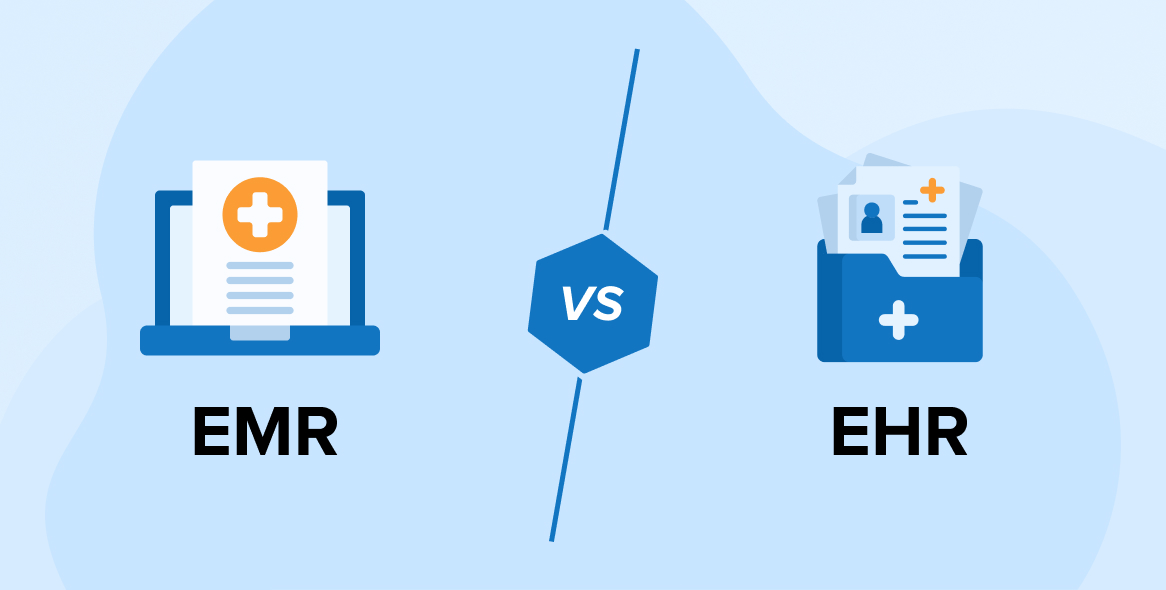
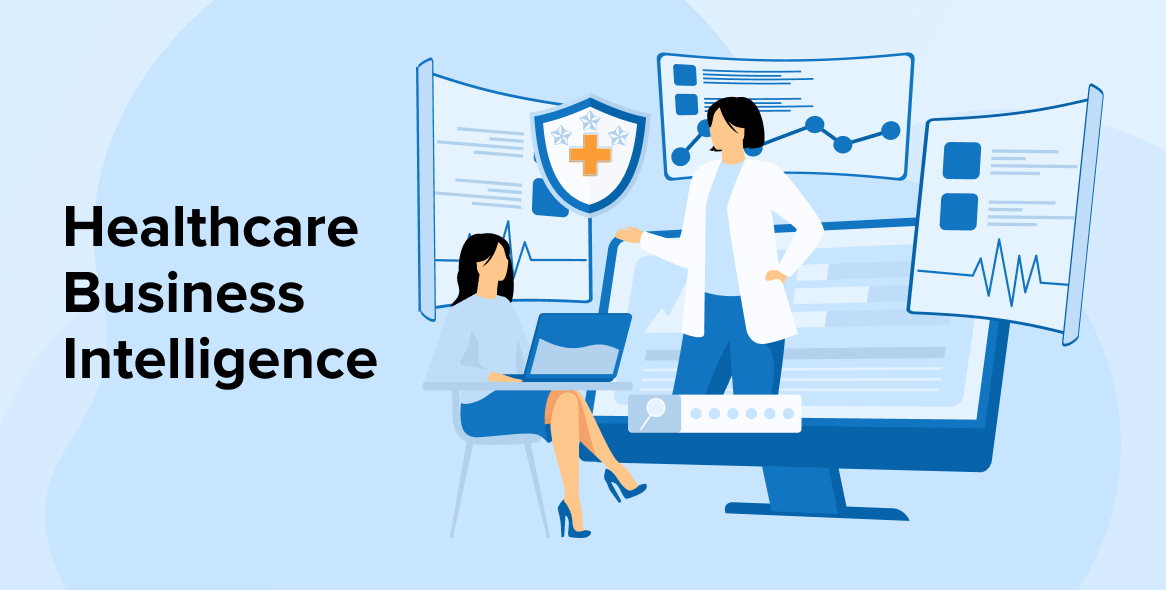
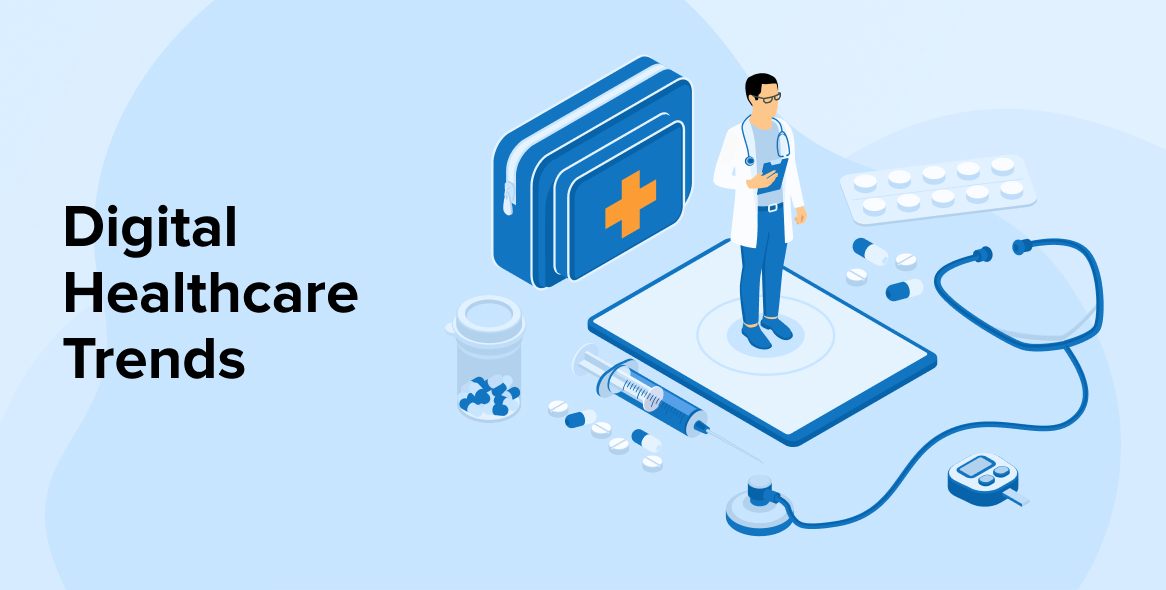

Comments
Leave a message...